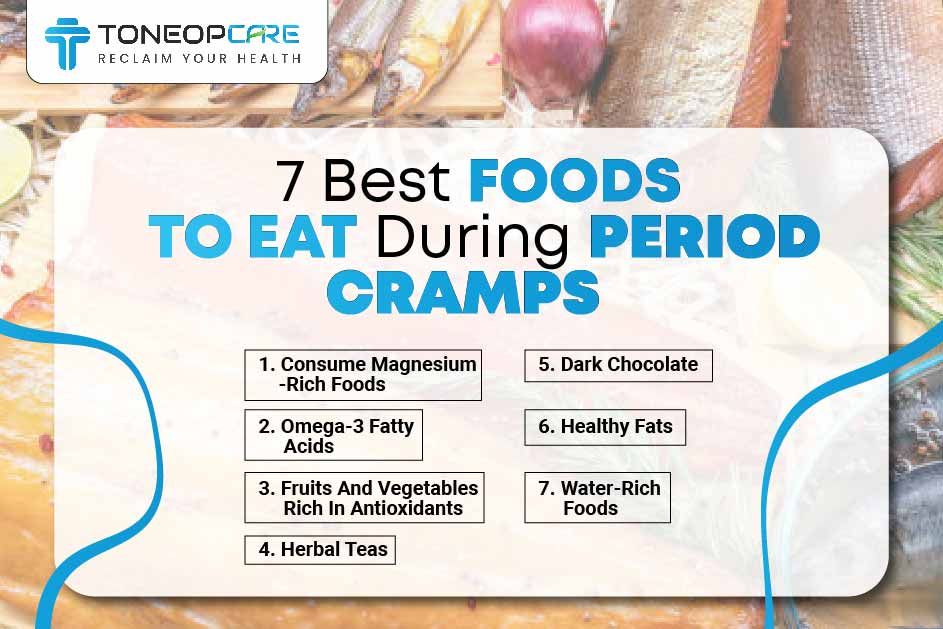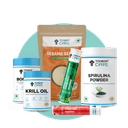We assure you that you won’t be alone on your journey towards becoming your healthier self.
Health & Wellness
7 Best Foods To Eat And Avoid During Your Period Cramps

Hello readers! Every month, women go through the natural and unavoidable process of menstruation, which brings along a range of physical and emotional changes. Common symptoms that women experience during this time include mood swings, cramps, bloating, and fatigue. These symptoms can vary from person to person, and managing them becomes more achievable when adopting a mindful approach to nutrition during this time.
Knowing the right foods to eat and those to avoid can significantly impact overall well-being. A balanced and nutrient-rich diet can contribute to hormonal balance and provide essential nutrients, while certain foods may exacerbate discomfort. This blog especially focuses on foods to eat and avoid during your period of cramps. It can be helpful for you and your loved ones to curate a well-managed meal plan to prevent discomfort or pain during menstruation. Continue reading to know more!
Table of Contents
- 7 Best Foods To Eat During Period Cramps
- Foods To Avoid During The Period
- Dietitian’s Recommendation
- The Final Say
- FAQs
- References
7 Best Foods To Eat During Period Cramps

During menstruation, many individuals experience discomfort, known as period cramps or dysmenorrhea. Certain meals can help reduce these symptoms because of their nutritional value and effects on the body.
1. Consume Magnesium-Rich Foods
To relieve periods of cramps, you can eat foods rich in magnesium. It is a natural muscle relaxant. During your period, your uterus contracts and sheds its lining. This cramping can be painful. Magnesium may help to relax these muscles and reduce cramping.
Magnesium may help reduce the production of prostaglandins, which can lessen cramps. Prostaglandins are hormone-like molecules that produce uterine contractions. They also play a role in inflammation and pain.
Magnesium can be found in foods such as leafy greens, nuts and seeds, bananas, avocados and whole grains. This mineral helps muscles relax which may reduce cramping.
Know More: Natural Period Care Supplement
2. Omega-3 Fatty Acids
Another good way to ease your period cramps is to eat foods rich in omega-3 fatty acids. When we consume omega-3s, our bodies convert them into compounds called resolvins and protectins. These resolvins and protectins have anti-inflammatory and pain-relieving effects. They work by counteracting the effects of omega-6 fatty acids, which are pro-inflammatory. Some rich sources of these fatty acids are fatty fish like salmon, mackerel, and sardines.
3. Fruits And Vegetables Rich In Antioxidants
Fresh fruits and vegetables are also a great way to relieve period discomfort and relax. They are high in vitamins and antioxidants, which can aid with menstruation discomfort. Some examples include berries, oranges, kiwis, pineapple, broccoli, carrots, and bell peppers.
4. Herbal Teas
Herbal teas can help reduce inflammation that causes cramping. Many of these teas contain compounds with anti-inflammatory properties. Ginger tea, for instance, is a popular choice for cramps because it contains gingerols and shogaols, which have anti-inflammatory effects. Chamomile tea is another great option with anti-inflammatory properties, thanks to a compound called apigenin.
Chamomile, ginger, and peppermint teas have a rich history of traditional use in relieving menstrual pain. These herbal teas, with their time-tested effectiveness, can help relax muscles, reduce bloating, and soothe the digestive system, providing relief during menstruation.
5. Dark Chocolate
Dark chocolate is a rich source of magnesium. This mineral helps to relax the muscles, including those in the uterus, which can significantly reduce cramping during menstruation. Additionally, magnesium may inhibit the production of prostaglandins, hormone-like lipids that cause uterine contractions.
Furthermore, dark chocolate has mood-enhancing properties due to its serotonin-boosting effects. Opting for dark chocolate with a high cocoa content may help alleviate menstrual symptoms and improve mood.
6. Healthy Fats
Fatty fish such as salmon, sardines, mackerel, and herring contain omega-3 fatty acids, as do flaxseeds, chia seeds, and walnuts. They have been found to lower prostaglandin synthesis, which causes the uterus to contract and contributes to cramping.
These are found in olive oil, avocados, nuts, and seeds. Monounsaturated fats may help reduce inflammation by increasing the production of beneficial prostaglandins and inflammatory ones.
7. Water-Rich Foods
Staying hydrated during menstruation is vital as dehydration can cause thicker blood, leading to cramps, headaches, and fatigue. Eat water-rich fruits like watermelon, cantaloupe, strawberries, and grapefruit to reduce the risk of cramps.
These fruits are also rich in electrolytes such as potassium and magnesium that assist with muscle contractions. Foods having lots of water, like cucumbers, watermelons, strawberries and celery can help to stay hydrated and lessen bloating during periods too.
Foods To Avoid During The Period
During your mеnstrual pеriod, it is advisablе to be mindful of certain foods that might еxacеrbatе symptoms. Hеrе arе sоmе recommendations on what to limit or avoid:
Food/Drink | Reason to Avoid | Healthier Alternatives |
Caffeine | Heightens irritability, anxiety, and breast tenderness | Decaf herbal teas (chamomile, peppermint) |
Salty Foods | Water retention, bloating, increased discomfort | Fresh, unprocessed snacks, herbs and spices for seasoning |
Processed Foods | Unhealthy fats, sugars, and additives worsen inflammation and symptoms | Whole, minimally processed foods (fruits, vegetables, whole grains, lean protein) |
Alcohol | Disrupts hormonal balance, intensifies mood swings and fatigue | Moderation or non-alcoholic alternatives (herbal mocktails, infused water) |
Sugary Treats | Blood sugar fluctuations, increased cravings and mood swings | Dark chocolate, fresh fruits, snacks with natural sweetness (dates, nuts) |
Dairy (if intolerant) | Digestive discomfort | Lactose-free or plant-based dairy alternatives (almond milk, soy milk, coconut milk) |
Dietitian’s Recommendation
As a dietician, I recommend a well-balanced diet that includes nutrient-dense options like fruits, green leafy vegetables, and essential fats in the form of nuts and fatty fish. These foods can make your period more comfortable regarding cramping and flow. Good sleep, light exercise, and adequate hydration are also key features in controlling menstrual symptoms. Moreover, sipping on some herbal teas may also soothe period cramping.
Dt. Aditi Upadhayay
The Final Say
Finally, what we eat during our periods can greatly impact our health. By opting for nutrient-rich options and avoiding highly processed foods, we can reduce inflammation, minimise discomfort, and promote overall menstrual well-being.
So, the next time you experience menstrual symptoms, listen to your body and choose nourishing, balanced foods that support stable energy levels and hydration. With these simple dietary changes, you can make your period more comfortable and enjoyable. For more information on health and supplements, visit ToneOp Care.


